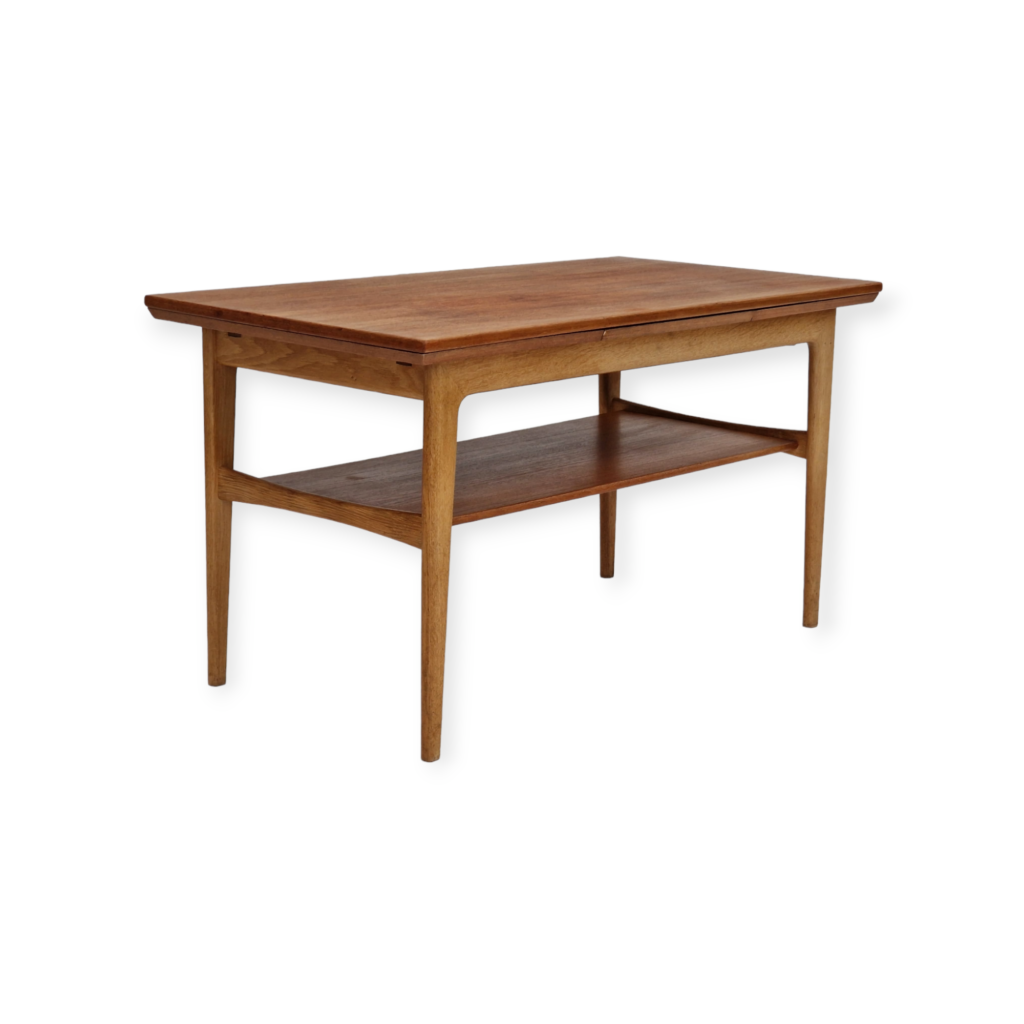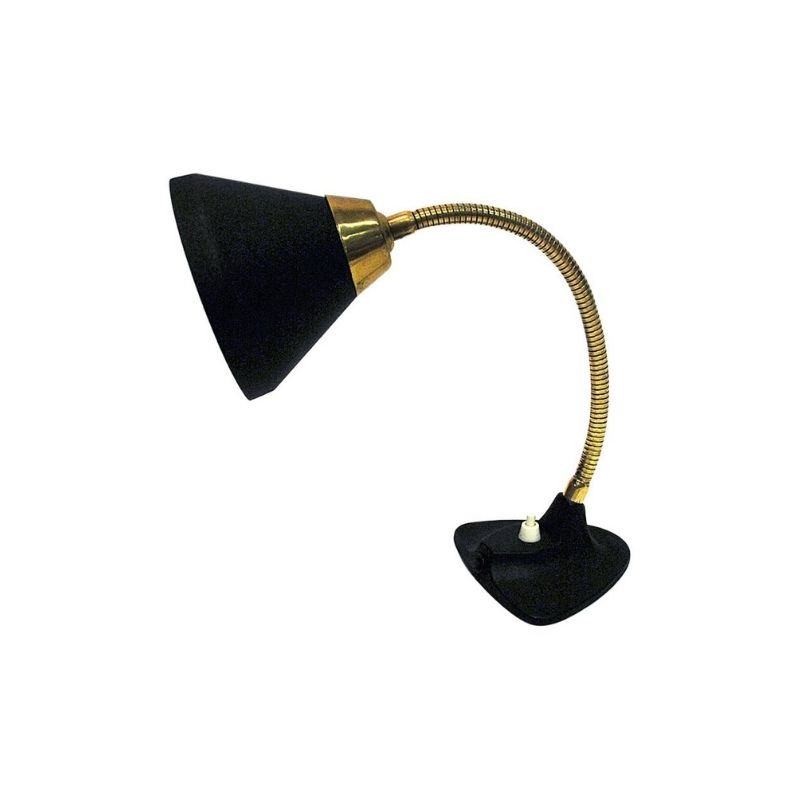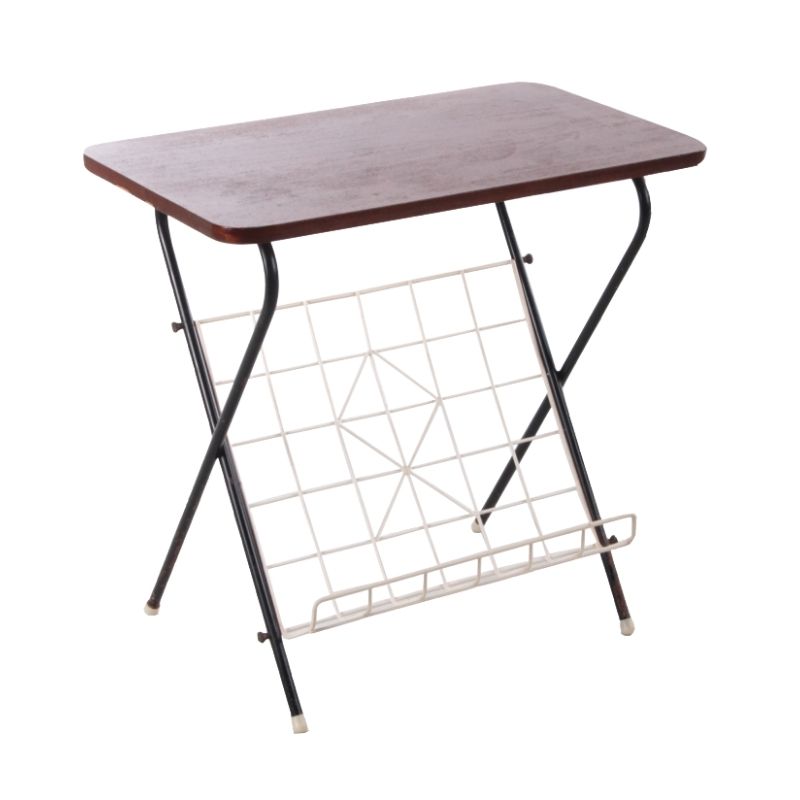I second Leif on almost all points.
Definitely teak.
I also prefer cord on my Moller chairs. If you prefer upholstery, though, it is not a difficult upholstery project. Probably the most difficult part in my mind would be replacing the foam. It is usually contact adhered to the beech, and somewhat sculpted to get good curves around the edges. I am a novice, and not clear on how best to scupt foam. If you are not an experienced upholster, it is worth your time to remove all of the staples, and try to get the fabric off intact. It will give you an exact template for your new piece of fabric.
The only original finish that has ever been used on Moller chairs is oil, as I understand it. If your finish is oil, then Leif's suggestion is certainly a way forward. There are others that are equally valid, and you can pretty easily find these online.
That being said, if you are seeing actual finish chipping off, and clouding, then I would be suspicious of whether a different finish was added at some point by a previous owner. It is extremely rare for oils to build a film thick enough to chip. If you are seeing finish chip off, then you probably have shellac, lacquer, or some sort of poly/varnish. There are specific things that would remove each of these, but Methylenechloride will remove all of them. Personally, I would not even mess with solvents if I had decided to strip, and just do it right with a proper stripper.
As far as sanding goes, it is not a restoration faux pas to sand, if you cannot tell that you ever sanded. In other words, you better know what you are doing, if you are going to take sand paper to wood in a serious restoration.
There are many people that prefer the patina, so not doing anything is certainly an option, as well.
It's fine to convert this chair to paper cord if you prefer that look, but you will have to either find someone to do the work and do it correctly, or learn to do it yourself (a little daunting but not impossible). The materials will cost more than fabric.
It's not at all hard to redo the foam. It's only 1/2" thick and all you do is make the rough cut big enough to cover the sides plus another 1/2" to 1". Wrap it and mark a line where it covers the entire side and a little bit to the underside (the rails are curved so you have to eyeball this a bit). Cut through this line perpendicular from the top surface to the back, undercutting at about a 45" degree angle. This gives you a nicely thinned-out edge that leaves no ridge when the fabric is pulled tight to the underside of the seat frame.
The fabric around the leg posts has to be clipped just so to fold under smoothly. You want a nice continuous curve with no fold and no angles. This is easier with (most) fabrics and leather than with vinyl. But any good upholsterer will know how to do this.
The fabric should be finished on the underside by cutting very close to the staples and cover the cut edge with black tape. If you can find black cloth bookbinding tape, great---otherwise I think black gaffer tape is an acceptable substitute?
Get a good Danish wool fabric, of course. I think there are some excellent English wools that would be perfectly acceptable.
I've used Murphy's Oil soap to clean teak and I just prefer to go over the wood with oil and #0000 steel wool unless the piece is caked with grime. The oil plus the steel wool will break down any dirt and will remove enough old, oxidized oil to noticeably brighten the wood and make it glow again. If you aren't satisfied with the results, you can always more on to a stronger cleaner from there.
I don't see anything on your chair that would indicate that it's been lacquered or shellacked. Some M
I don't like scrubbing with the solvents.
The last time I tried to remove shellac with DNA, it was as more of a mess than if I had just used methylene chloride, and 3 times the scrubbing and elbow grease. I prefer to just brush the MC on, let it sit for s bit, and then scrape it off. Sure you have to rub it down with a solvent afterward, but that is just a light scrub to remove the remaining MC that did not get scraped.
I am probably just not doing it right, but I go for the method that I know works and that I know how to do. I would love to swing by your shop Spanky and get some pointers, .... if only I were around your location.
Thank you so much guys. The grain is on both of the arm rests - not just the knotted side - and the flash certainly didn't accentuate the contrast in tone on the backrest. Just trying to justify why I thought it may have been rosewood. I feel kind of silly now, but it is really hard to tell between unfigured rosewood and dark teak sometimes.
I also compared it to the solid rosewood I have that's been sunbleached and thought it could be that, I do have some really faded rosewood. Besides, the advice you guys have given will be helpful regardless of the the wood I am sure.
As to that advice - I am certain someone has put a finish on, it's not a horrible one, but there IS cracking, especially on the joints between the arms and beside the scratches and some really opaque parts all up and down the legs and the backrest. I also plucked up the courage to lift up the seat meaterial and I can see a line between the finished wood and the non finished. Incidentally, this was another factor that made me question the type of timber.
My concern is that it's a teak oil or something that's had lacquer in it, and it's been built up, not a shellac or the like.
So I will see if it comes off with some alcohol and if not I'll use some stripper I already have. Presumably I can forgo the Muphy's at that stage(presuming I can even pick Murphy's up in the UK).
Then I will do a really light and fine sanding and re-oil.
Is Teak oil advisable then? I feel like something more basic like boiled linseed would be better? Any opinions?
Just to be clear, alcohol will remove shellac. Acetone will remove lacquer. If neither of these solvents work to remove the finish, then it's probably varnish or polyurethane and then you absolutely do need to use stripper.
Hold off on the sanding until you have the finish off and the entire surface clean of all residues and dust and bits of steel wool, etc. It may not need sanding at all.
Teak oil is just the name of products sold for oiling teak, it doesn't come from teak trees at all. Most of it is just linseed oil with a solvent to thin it out, and some brands have added varnish to give the finish more protective qualities. Leif can tell you about tung oil finishes.
Just to be clear, alcohol will remove shellac. Acetone will remove lacquer. If neither of these solvents work to remove the finish, then it's probably varnish or polyurethane and then you absolutely do need to use stripper.
Hold off on the sanding until you have the finish off and the entire surface clean of all residues and dust and bits of steel wool, etc. It may not need sanding at all.
Teak oil is just the name of products sold for oiling teak, it doesn't come from teak trees at all. Most of it is just linseed oil with a solvent to thin it out, and some brands have added varnish to give the finish more protective qualities. Leif can tell you about tung oil finishes.
I agree, teak vs. rosewood can be a tricky call sometimes, especially when deep down you want it to be rosewood (which is often how it goes for me).
Probably does not matter too much which oil you use. I typically don't use Linseed Oil, since the time necessary for it to set up is really long. Boiled Linseed Oil (BLO) is definitely better than straight LO, but still not hing on my list for furniture application. If you are looking for a natural oil, I would recommend pure Tung Oil over BLO.
All this said, I am in the process of a complete restoration of 4 Moller 75's, and 2 Moller 55's. I have all the 75''s refinished, and two of them rewoven. I used Watco Teak Oil with great results. I started from bare wood, and applied probably 9 coats. 6 of the coats were with OOOO steel wool, and the remaining 3 with lint-free cloth. The coats were applied over a two week period, where I let each coat set up before applying the next. The final results are really pretty good. I usually try to use Starbright teak oil, but I have been out for a while now, and just haven't ordered more. The Watco was available at the local store.
I have also refinished a Moller 77 in teak, with Watco Danish Oil, and the results were also not too bad. Teak oil tends to have some reddish tone in it, which typically makes the teak more rich, in my opinion.
By the way, I also saw that chipping near the back rest joint. As Spanky said, diligent application of oil over 50+ years (especially oil products with have varnish blended in, which many do) can build a film. But, it is far more likely that someone added an actual film finish. Shellac is brittle, and clouds when exposed to moisture, so that would be my guess based on the info, but it certainly could be any of the other film finishes out there, since many act in similar ways.
Good luck, and I am sure you will get it done right.
Thanks for the advice. I don't have a ton of experience so speaking to all of you is a really valuable resource.
I kind of knew I'd struggle to irreversibly screw it up, but I also know that these pieces aren't a dime a dozen and it's in everyone's best interests that I do it correctly. We don't need one less in the world.
And I also feel like a unanimous take on the type of timber was invaluable. I will probably have 3 extra hours a week in which I am not poring over every inch of the chair to try to identify which bits look like rosewood and which don't. You're very right about what I was hoping, but it's an amazing chair regardless of the wood - definitely my favourite Moller chair along with the 77 (which I now need to find a couple of!)
Once again thank you Zephyr, Spanky and Leif! I shall update when I make progress.
I will probably palm the upholstering off to a professional, I can deal with wood - but upholstery really isn't a strong point for me.
Kyle
Zephyr, sorry, I missed your response to the shellac issue--sounds like the alcohol didn't have enough time to dissolve the shellac. Sometimes there are many coats of shellac and it just takes awhile to get through them. I lay a paper towel on the shellacked surface (or do a single layer wrap on legs, rungs, etc) and saturate that with alcohol, let sit. Rewet as needed until all the shellac is dissolved, then just wipe off.
I came up with this technique when I was stripping eight 6' high double hung windows, three rooms' worth of tall baseboards, nine or ten paneled doors & trim, and a staircase with bannister, balusters, and probably some other stuff that I can't remember because i didn't use a respirator (oh to be young and stupid again!) It had all been shellacked, shellacked again, and then shellacked a few more times over the years--probably because recoating seemed like the easiest way to make it look nice again every time it began to dull. The result was a very deeply alligatored texture that looked horrible. It took me 2 1/2 years to get it all done (working an average of 4-5 hours a week on it, since I had little kids and obvs could not do it when they were anywhere near.) Good times. But I did learn an awful lot about removing shellac.
And now i'm going to hold my breath and see if these photo links work...
Nice work Spanky, that is one heck of a big job, and clearly, from your pictures, made a world of difference.
I am ADD to the extreme, so I just dont have the patience to go the solvent route, especially when the piece is something I am planning to sell. I agree that it works, and that it is cheaper materials-wise, and that all things considered is less chemically dangerous than methylene chloride. I will give it another try, using the soaking method, next time I come across a shellac refinish.
Yeah, ultimately we all have to decide what the best way for ourselves how to do a given task. But it's always good to have a thorough grounding in the available methods. I do find that lacquer dissolves faster than shellac---maybe because it's usually not multiple coats? Most of the lacquered stuff I've dealt with just a a very thin coat.
Auntie---I got impatient and went to Photobucket and opened an account just for photos for DA (until the glitch is fixed, that is) and used the HTML option for posting them here. Just copy and paste it into the body of the message. Don't attempt to use the "Add a photo" function. Well, you can...but i don't think anything will happen.
When it works, toast yourself repeatedly and think of me.
If you need any help, please contact us at – info@designaddict.com









